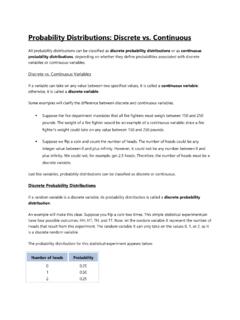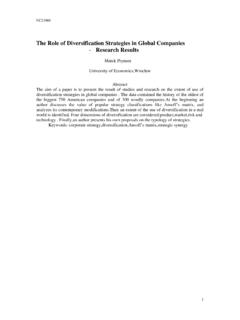Transcription of Growth Strategies - CA Sri Lanka
1 4/3/2017 1 Growth Strategies ansoff matrix ansoff matrix Market Existing Existing Market Penetration New Product Development New Market Development Diversification Product 4/3/2017 2 Market Penetration is an increase in the same types of items to the same types of customers. Market Development is the addition of new customers to an already existing customer base. Product Development is an increase in diversity of products to already existing customers. Product Diversification is simply new products for new customers. Market penetration Market penetration is where the company gains Market share . Either the number of consumers using the product that is bringing in new consumers. Consumption levels of the existing consumers It mainly aims at 4 objectives- Enhancing market share of the existing products Securing market share of dominant markets Restructure the existing market by thrashing out competition by aggressively promoting the product.
2 Increasing consumption levels of existing consumers 4/3/2017 3 Aim Risks Contents How is it Achieved When to use it Examples Market Penetration Increase a share in the current market with current products and secure dominance In a growing market, or change an existing market by driving out competition. There are minimal risks in market penetration. Market penetration is the strategy involving the least risk out of the four. However because risk is low, so is success. Penetration includes an increase of existing goods to an already existing market. You are essentially selling more of the same thing to the same people. Difficult if market is saturated. Success is achieved through multiple things. Increased sales to customers, attract customers from rivals, gaining market share at the expense of rivals and encouraging non buyers to buy.
3 There are certain times to use it. Some are, when the market is NOT saturated, when there is Growth in the market, competitors share in the market is falling and increased volumes lead to economies of scale. An example of market penetration is when Tesco increased its share of the grocery business during its competitors struggles. 5 Market Development Under this, the firm sells existing products in new markets which can be done through- Exploring new geographical markets Changing the packaging for the new markets Developing new distribution channels Differentiated pricing in different markets. 4/3/2017 4 Market Development Aim Risks Contents How is it Achieved When to use it Examples An example of Market Development is when Tesco expanded into the convenience store market. Moderate risks come with Market Development.
4 There is also a lack of familiarity with customers, but the product stays familiar. Market Development is best used when untapped markets are beckoning, the firm has excess capacity and there are attractive channels to access a new market. Selling the same product to a newer, expanding customer base or entering new markets with the same base. Basically gaining new customers with the same product. This will include changes to many different aspects of a firm, such as marketing Strategies , new distribution channels, a different pricing policy and many others. The aim of market development is basically to expand the market and customer base of a firm or company. Product development Product development can differ from the introduction of a new product in an existing market or it can involve the modification of an existing product.
5 By modifying the product one would probably change its outlook or presentation, Its requires R & D Its requires assessment of customer needs Its requires clear path of brand extension 4/3/2017 5 Product Development Aim Risks Contents How is it Achieved When to use it Examples Two examples are Tesco expanding petrol sales and the development of financial services. The aim of Product Development is to create new products for an already existing market. The creation of new products is usually quite costly and there are moderate risk levels associated. Probably the biggest risk is will this new product be successful. Companies usually utilize product development when they have strong Resource and Development capabilities, the market is growing and there is rapid change. This could be new products to replace current older ones, new innovative products, product improvements or product line extensions.
6 What makes Product Development easiest, is a strong Research and Development program, also known as R&D. Without this, it is very risky and has a lower success rate. Diversification Diversification is the name given to the Growth strategy where a business markets new products in new markets. This is the most risky strategy because the business is moving into markets in which it has little or no experience. There are two types of diversification. There is related diversification and unrelated diversification. 4/3/2017 6 Diversification Related Diversification Vertical Diversification- Became own supplier or Customer Forward Integration Became own customer Backward Integration- Became own supplier Horizontal Diversification- Merge or acquisitions with competitor Un related Diversification- New Product to New Market COCA-COLA: ansoff matrix ansoff s matrix , it has been applied to Coca-Cola, the most well-known trade name in the world and a company today operating in over 200 countries; and a brand that has undertaken countless Growth Strategies in its 100+ year history.
7 4/3/2017 7 COCA-COLA: ansoff matrix Market Penetration Due to the incredible strength of Coca-Cola s brand, the company has been able to utilise market penetration on an annual basis by creating an association between Coca-Cola and Christmas, such as through the infamous Coca-Cola Christmas advert, which has helped boost sales during the festive period. 4/3/2017 8 Product Development A prime example of this was the launch of Cherry Coke in 1985 Coca-Cola s first extension beyond its original recipe and a strategy prompted by small-scale competitors who had identified a profitable opportunity to add cherry-flavoured syrup to Coca-Cola and resell it. The company has since gone on to successfully launch other flavored variants including lime, lemon and vanilla. Market Development The launch of Coke Zero in 2005 was a classic example of this its concept being identical to Diet Coke; the great taste of Coca-Cola but with zero sugar and low calories.
8 Diet Coke was launched more than 30 years ago, and whilst more females drink it every day than any other soft drink brand, it came to light that young men shied away from it due to its consequential perception of being a woman s drink. With its shiny black can and polar opposite advertising campaigns, Coke Zero has successfully generated a more masculine appeal. 4/3/2017 9 Related Diversification: in order to penetrate a new but related market. In 2007, Coca-Cola spent $ billion to acquire Glaceau, including its health drink brand Vitamin water. With a year-on-year decline in sales of carbonated soft drinks like Coca-Cola, the brand anticipates the drinks market may be heading less-sugary future so has jumped on board the growing health drink sector.



















